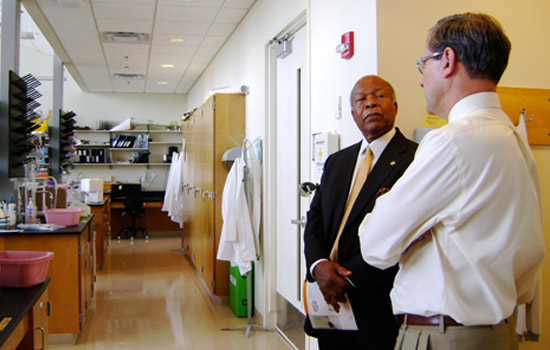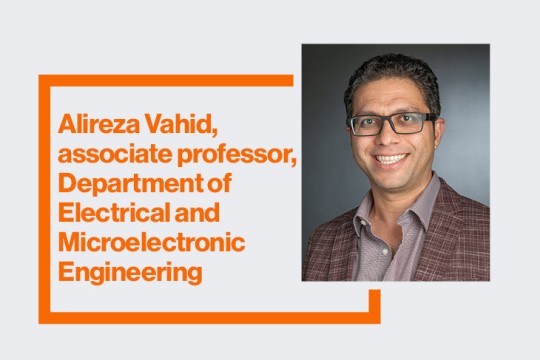Louis Sullivan, former health secretary, meets with local university and community health care professionals
Group explores development of Sullivan Alliance to support healthcare initiatives
M. Cometa
Former U. S. Secretary of Health and Human Services Louis Sullivan recently toured laboratory facilities in the Center for Bioscience Education and Technology with Richard Doolittle, professor of medical sciences and assistant provost for undergraduate education. Sullivan was on campus to discuss diversity in health care and the changing trends in the health care field.
The health care reform bill is expected to extend medical care to a broader group of people in the United States. This poses a challenge to the health care community that must accommodate the larger numbers of individuals and ensure that there are adequate numbers of professionals to provide health services.
Louis Sullivan, former U.S. Secretary of Health and Human Services, met with representatives from area universities and community health organizations Sept. 13 to discuss developing a Sullivan Alliance for the area to support these challenges.
Sullivan, cabinet secretary for former President George H. W. Bush from 1989 to 1993, is an expert in public health policy and has worked in subsequent years on improvements to health care delivery, especially in the area of enhancing diversity. In 2005, he established the Sullivan Alliance to Transform America’s Health Professionals. The organization focuses on raising awareness about the value of racial and ethnic diversity in the health care professions and on supporting academic programs in a broad variety of health care disciplines.
Participating in early discussions about a possible alliance were representatives from Rochester Institute of Technology, St. John Fisher College, the University of Rochester, Excellus Blue Cross Blue Shield, the Roswell Park Cancer Institute and the Rochester General Health System.
Programs such as the Sullivan Alliance cultivate students who express interest in pursuing careers in the health sciences and other disciplines, says Kevin McDonald, RIT’s chief diversity officer and one of the discussion participants.
“The alliance can also provide opportunities to share intellectual talent and technical expertise between cross-functional partners and identify strategies for securing research funds that lead to creative approaches to the reduction of barriers to health care,” he adds.
Discussions about the Sullivan Alliance will continue throughout the next few months.
While at RIT, Sullivan toured several of the medical simulation and anatomy laboratories in the Center for Bioscience Education and Technology, learning about some of the undergraduate research being done in the facility and in other areas on campus.
“Universities are tied in many ways to providing training for new professionals. There is a need for more Ph.D. scientists,” he says, noting that change is taking place within health care as more emphasis is placed on the value of interdisciplinary work among professionals.
He praised the growing trends of interdisciplinary teams able to work with diverse, multi-cultural populations that could make up the 32 million individuals expected to enter the health care system under the new bill.
“Health care is a very personal experience,” Sullivan says. “The need to be able to understand different languages and cultures will be essential for new health care providers as the demographics in the U.S. change in the next 20-30 years.” He referred to studies that project a need for nearly 160,000 new physicians and public health professionals to meet the growing need.
“The U.S. has a long history of excellence in the sciences,” Sullivan says. “Unless the approach to health care changes, with enthusiasm and with more resources, we may not be able to maintain that level of excellence.”















